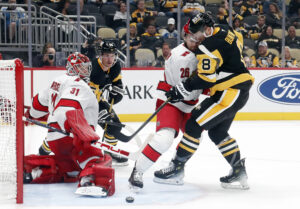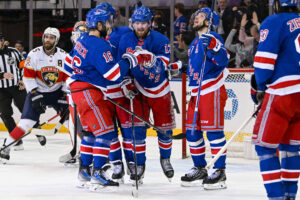With the hiring of Cammi Granato, the Vancouver Canucks are once again back to a full administration. All the names are in place for decisions to be made. So what is general manager Patrik Allvin going to do first? Of all the possibilities, what is the Canucks riskiest move, and will they take it?
Risk Management or Bold Moves
With the near-wholesale replacement of the white-collar jobs, trades are coming next. Some of these are going to be easier to do than others, of course. But moves – plural – are happening. What fans want to see from the new group is a plan, and the team acting on it. Plans are going to come with different challenges and different stakes, especially if fan opinion is taken into account. As per usual, CapFriendly has been an absolutely invaluable resource here.
No Risk Because Not Happening
There are several options available, but some are simply not going to happen.
Doing Nothing
Doing nothing, while it would be the Canucks riskiest move, isn’t an option. Not only has the president of hockey operations Jim Rutherford said he wants more cap space, but he also said he wants to compete in a couple of years. Neither of those is happening without changes to on-ice personnel.
Coaching Change
Nah. The team is playing better under Bruce Boudreau, even with their recent losses. Boudreau was suggested by Rutherford in the convoluted “hired-fired-who” days of transition. He’s not going anywhere. Neither are his assistants.
Anchors Away!
Exactly three players are not going anywhere, full stop, period. Elias Pettersson, Quinn Hughes, and Thatcher Demko are going to anchor whatever future this team has. The only packing they should do is for road trips or seeing family members perform magic in Vegas.
Low Risk, Low Reward
Keeping an eye on the long-term future won’t hurt. That doesn’t necessarily mean big moves, and more than one of these could happen on their own or with others.
Shuffling the Deck
Moving players up and down from Abbotsford is almost certainly going to happen. Fans are calling for Jack Rathbone to come up, and they have a good reason, but the team wants him to develop there. He’s getting all the ice time he can eat in the AHL and has yet to play even half a season at any professional level. Other than him, though, the options are wide open.
We expected the year to start with Phillip Di Giuseppe on the team, with Nic Petan as an option. Justin Dowling has been put on waivers, so giving other players a shot is coming. Alex Chiasson, despite his four power-play goals, is a point of frustration for Canucks fans. Moving either forward – through trade or demotion – isn’t changing much. There are fewer options on the defence, though. Moving out locals Noah Juulsen, Brad Hunt, or Kyle Burroughs when they are perfectly useful is pointless. Replacing them would cost as much as keeping them.
A little higher up, however, and there is some reward to be had. If a team can be convinced to take on Travis Hamonic‘s two years or Tucker Poolman‘s four? That will return the benefit of their absent contracts. Cap space matters. The players are useful, though not at what they cost.
Risk Level Pending
The previous ones aren’t moving any needles, really. They could be a part of the plan or not happen at all with very little difference. Let’s get to something more interesting. If these aren’t the Canucks riskiest moves possible, they can still inspire a fan or two to perspire.
Gold, Jimothy! Gold!
Why on Earth would a team move their best forward who is on an excellent contract? And why would anyone sane call that a lower-risk deal? By the simple expedient of there being zero – none – pressure to deal him. Any team looking for a versatile, top-line centre will want him, and any team hoping for a good playoff run will want him NOW. Why trading J.T. Miller would be far from the Canucks riskiest move is simple: the return. With Miller under contract for another year, the team can simply say no. In fact, they may well get more in the off-season as teams fail out of the first round this year.
That being said, there is always risk when a team trades for youth and/or prospects. Picks may not pan out, or a young play could have already peaked. But with more teams interested comes a greater variety of offers. That alone reduces the risk of moving such a valuable piece.
Spin the Wheel
The best part of a new management team is they have no loyalty to any particular player. Deals struck by the previous lot are their fault and our problem. You know the routine. But when the deal that was made is actually pretty good it’s harder to move on from. And Conor Garland‘s is… pretty good. He’s not getting the first-line use he got in Arizona, but he’s a solid top-six contributor. That he’s signed for another four seasons was a bonus in pre-pandemic years, perhaps a little less so now. Any sale of him may be at a low, with his boxcar numbers down from last season. He’s also very popular among the fans. Unless the return is clearly on the Canucks side, moving Garland could hurt.
About That Bonus…
Jaroslav Halák was having a perfectly fine season until those meddling New York Islanders got involved! Up until he earned an extra $1.5 million by letting in five goals on 12 shots, Halák’s year was going fine. But even with that miserable period, there should be interest in the goaltender if he is on the market. He’s also got a full no-move clause, so it’s not like the team can force him to leave. That severely limits the number of potential suitors, which does drive down the price. One of the few teams that a deal makes sense for is the Edmonton Oilers – if Halák chooses to go.
The other half of the move is what happens next. If the Canucks have any thoughts for the playoffs, they are going to be relying on Spencer Martin. His performance has been mostly solid over his three games. That is death for a team already on the very margins of a playoff race, and one of the teams they’re chasing is Edmonton.
For Sale! Flashing Lights and Klaxons!
Hoo, boy. These are possible trade targets, but it would be quite the coin flip to act on them. Extremely high risk, given the potential involved and what the return might be.
Fun Isn’t Everything
Nils Höglander making the team was a pleasant surprise last season. This year’s numbers aren’t as good, but then no one else’s is, either. Much like Garland, the Umlaut Special is a blast to watch on the ice but he doesn’t provide much size. More a pitbull to Garland’s whirling dervish, he’s built for a high-pursuit game. But Boudreau has also cut his ice time down since arriving, and as long as the team wins that’ll pass. But his production has also fallen off, meaning any selling comes based on potential. Hopefully.
Höglander’s current contract isn’t quite bargain-basement, but it’s still sub-$1 million for another year. It may be that his first season will be his best, but given his work rate that seems very unlikely. And given that he’s all of 21 years old, moving him out can very easily be a deal that fans point to a decade from now, saying “we used to have him.” But even moving the sophomore wouldn’t be the Canucks riskiest move.
Scoring Isn’t Everything, Either
Any trade involving Brock Boeser is the Gold Standard of risk assumption – for both teams. He’s turning 25 this month, so it’s hard to call him a prospect or even particularly young. He is what he is. Kind of. He can score goals, there’s no question of that. While he was a bit questionable defensively in his first couple of seasons, he has improved there dramatically. He’ll willingly go into the corners to get the puck or net-front to deflect it. He’s a very good player and should be a 30-35 goal scorer for a few years yet. Except he never has been.
Obviously, there are a couple of years where a full season didn’t happen. Outside of those, however, he does have a history of injuries that stopped him from reaching the 30-goal mark. His .38 is the highest goals-per-game of anyone on the club for the past six seasons, except Tyler Toffoli‘s ten games. Combine those two facts with a $7.5 million qualifying offer needed when this season ends and you end up with high stakes for any team signing him. Given the hardship Boeser has already faced, it’s really hard to bet against him.
The Vancouver Canucks riskiest move this year is going all-in trading – OR signing – Brock Boeser.
Main Photo:






